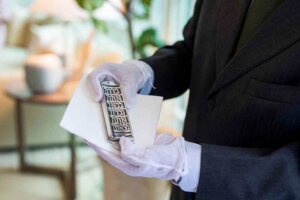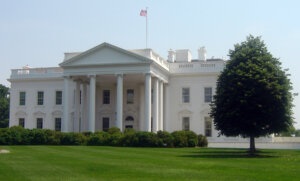Second Gentleman Doug Emhoff affixes a mezuzah at the vice president’s residence in Washington, D.C., in 2021. Courtesy of The White House
Vice President Kamala Harris’ likely presidential nomination has Democrats dreaming of history: First woman in the Oval Office. First Jewish First Gentleman. First…White House mezuzah?
Second Gentleman Doug Emhoff hung a mezuzah — a decorative box containing biblical text — in the entryway of the vice presidential residence after he and Harris moved in there in 2021. And he suggested he’d do the same at the White House should his wife defeat former President Donald Trump in November.
“I’m just gonna keep living life openly as a Jew, and maybe there’ll be a mezuzah in the White House, just like there is in the vice president’s residence,” Emhoff said at a July 24 event with the Jewish Democratic Council of America.
But we still have questions. Would Emhoff take his mezuzah from the vice presidential residence? Where would he hang it? What does Jewish law actually require? And would this actually be the first White House mezuzah?
The Naval Observatory mezuzah
The Torah requires Jews to hang on their doorposts a mezuzah, which is simultaneously an aesthetic statement and — for many — an enchanted object; when a string of bad luck befalls a Jewish person, a common instruction is to check your mezuzah’s scroll for imperfections.
So when the Second Couple decided in 2021 to hang a mezuzah at the vice president’s mansion on the grounds of the U.S. Naval Observatory in Washington, D.C., they couldn’t just pick something out on Etsy. Instead, they enlisted Francesco Spagnolo, curator of University of California’s Magnes Collection of Jewish Art and Lifeto find the perfect totem for their new home.
Spagnolo said in an interview that from the hundreds of mezuzahs in the collection he presented at least three options. Two came from India, which he thought might resonate with Harris, who is of Indian descent. Another had been a gift from Leah Rabin — wife of former Israeli Prime Minister Yitzhak Rabin — to Rabin’s English-language secretary, Alice Grossman. Its connection to the vice president, Spagnolo said, was “women in service.”
Emhoff and Harris selected the Rabin mezuzah, whose sterling silver, art nouveau-style case bears a Hebrew benediction that translates to: “Blessed shall you be in your comings, blessed shall you be in your goings.”

“It’s a reminder of the transient nature of political power,” Spagnolo said. “There is a sense of coming and going and not just being there permanently. So all of these meanings are embedded in this object.”
As for the scroll containing the Shema prayer that goes inside the mezuzah? Spagnolo purchased it at a Bay Area Judaica store.
Would a Jewish First Couple be required to hang a mezuzah at the White House?
Generally speaking, halacha, or Jewish law, requires Jews to put up a mezuzah on every non-bathroom doorpost in any residence where they plan to live for at least 30 days, according to Rabbi Hyim Shafner, leader of Kesher Israel Congregation, an Orthodox synagogue just over a mile from the White House.
Of course, the White House comprises more than just a house; its West Wing and East Wing are office buildings. But in the Executive Residence alone — that’s the White House you see on postcards, and where the president’s family lives — there are 412 doors.
Whether halacha would consider Harris and Emhoff a mezuzah-mandated resident, though, is up for debate.
Rabbi Ari Zivotofsky, who writes about halacha for the Orthodox Union, seemed skeptical that Emhoff would be required to put up a single one.
Noting that the president does not acquire or lease the White House — which technically belongs to the National Park Service — he likened the Executive Residence to “a very fancy, fancy dorm room.”
In terms of halacha, a dorm resident does not have the status of a homeowner, or even an apartment tenant — their dorm fees cover housing, but not any particular room. And thus they are not required to affix a mezuzah.
Zivotofsky pointed out that as the spouse of Harris, Emhoff at the White House would be not only the guest of the National Park Service, but also the guest of the president herself — another degree of separation from ownership of the space. Therefore, he said, the mitzvah, or commandment, to put up a mezuzah at the White House would be purely optional.
Shafner said the First Couple’s residential status was irrelevant — and the Executive Residence was not different from a dorm room, which he insisted did require a mezuzah — because the students would be living and eating in the space for a period longer than 30 days.

It sounds like Emhoff is bent on putting one up in the Executive Residence if he gets the chance. Can he do that? Has that ever been done before?
The short answer is yes, the president’s husband can do that, though the Committee for the Preservation of the White House might suggest using two-sided tape, rather than screws, on the portico’s sandstone facade.
According to the White House Historical Association, while presidents and their families can make changes throughout the Executive Residence, they tend to make most of their changes on the second floor — their private quarters — leaving the first floor mostly intact.
So a Harris-Emhoff mezuzah might be the first one in the Executive Residence, but possibly not in the White House altogether. It depends on what you count as the White House.
We also found someone who hung a mezuzah in a building that might fairly be described as the White House complex during the Bush Administration — but who isn’t Jewish himself: Jim Towey, former head of the White House Office of Faith-based and Community Initiatives under President George W. Bush.
Towey, who is Catholic, knew about the tradition from Jewish roommates from law school. When he started a nonprofit serving the elderly in Tallahassee, he’d put one up in his office “as a reminder as of God’s presence in the midst of the work I was doing in support of human dignity.”
So when he got the Washington job in 2002 and moved into the building adjoining the Blair House — the historic guest house for presidential guests — putting up a mezuzah in his office, he said, was a “no-brainer.”
A clergy friend in Miami, the late Rabbi Solomon Schiff, sent him a two-toned brown mezuzah to use and instructions on how to hang it — the mezuzah should lean toward the inside of the room — but Towey could not remember who put it up.
“I remember I was given some instructions about how to angle it,” Towey said.
He took it with him when he left, and now the mezuzah hangs in his office in Tallahassee. Would he consider his old office next to the Blair House — which is a few hundred feet from the White House entrance — to be part of the White House?
“It depends on how technical you get,” Towey said. “It’s all staffing for the president. So I was part of the Executive Office of the President, and so it’s one of the offices of the White House. Mail sent to the White House got to me.”
Even if Emhoff’s mezuzah is merely the first in the Executive Residence, Shafner said Harris’ husband would be empowered to say a shehecheyanu blessing, to mark a new experience, along with the regular blessing for putting up a mezuzah.
And though he did not think it would not be required, an optional mezuzah would still confer an important benefit for a president or her spouse: Every time you walk past it, Zivotofsky said, paraphrasing the 12th-century Jewish sage Maimonides, “it reminds you that there is a higher power.”

I hope you appreciated this article. Before you go, I’d like to ask you to please support the Forward’s award-winning, nonprofit journalism during this critical time.
Now more than ever, American Jews need independent news they can trust, with reporting driven by truth, not ideology. We serve you, not any ideological agenda.
At a time when other newsrooms are closing or cutting back, the Forward has removed its paywall and invested additional resources to report on the ground from Israel and around the U.S. on the impact of the war, rising antisemitism and the protests on college campuses.
Readers like you make it all possible. Support our work by becoming a Forward Member and connect with our journalism and your community.
— Rachel Fishman Feddersen, Publisher and CEO



















